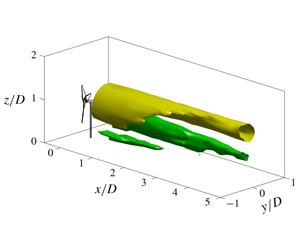Crossref Citations
This article has been cited by the following publications. This list is generated based on data provided by
Crossref.
Lin, Mou
and
Porté-Agel, Fernando
2019.
Large-Eddy Simulation of Yawed Wind-Turbine Wakes: Comparisons with Wind Tunnel Measurements and Analytical Wake Models.
Energies,
Vol. 12,
Issue. 23,
p.
4574.
Brugger, Peter
Debnath, Mithu
Scholbrock, Andrew
Fleming, Paul
Moriarty, Patrick
Simley, Eric
Jager, David
Roadman, Jason
Murphy, Mark
Zong, Haohua
and
Porté-Agel, Fernando
2020.
Lidar measurements of yawed-wind-turbine wakes: characterization and validation of analytical models.
Wind Energy Science,
Vol. 5,
Issue. 4,
p.
1253.
Howland, Michael F.
González, Carlos Moral
Martínez, Juan José Pena
Quesada, Jesús Bas
Larrañaga, Felipe Palou
Yadav, Neeraj K.
Chawla, Jasvipul S.
and
Dabiri, John O.
2020.
Influence of atmospheric conditions on the power production of utility-scale wind turbines in yaw misalignment.
Journal of Renewable and Sustainable Energy,
Vol. 12,
Issue. 6,
Shapiro, Carl R.
Gayme, Dennice F.
and
Meneveau, Charles
2020.
Generation and decay of counter-rotating vortices downstream of yawed wind turbines in the atmospheric boundary layer.
Journal of Fluid Mechanics,
Vol. 903,
Issue. ,
Fleming, Paul
Sinner, Michael
Young, Tom
Lannic, Marine
King, Jennifer
Simley, Eric
and
Doekemeijer, Bart
2021.
Experimental results of wake steering using fixed angles.
Wind Energy Science,
Vol. 6,
Issue. 6,
p.
1521.
Abraham, Aliza
Martínez-Tossas, Luis A.
and
Hong, Jiarong
2021.
Mechanisms of dynamic near-wake modulation of a utility-scale wind turbine.
Journal of Fluid Mechanics,
Vol. 926,
Issue. ,
Zong, H.
Su, Z.
Liang, H.
and
Wu, Y.
2022.
Experimental investigation and reduced-order modeling of plasma jets in a turbulent boundary layer for skin-friction drag reduction.
Physics of Fluids,
Vol. 34,
Issue. 8,
Kim, Hyebin
and
Lee, Sang
2022.
Large Eddy Simulation of Yawed Wind Turbine Wake Deformation.
Energies,
Vol. 15,
Issue. 17,
p.
6125.
Feng, Dachuan
Li, Larry K.B.
Gupta, Vikrant
and
Wan, Minping
2022.
Componentwise influence of upstream turbulence on the far-wake dynamics of wind turbines.
Renewable Energy,
Vol. 200,
Issue. ,
p.
1081.
He, Ruiyang
Sun, Haiying
Gao, Xiaoxia
and
Yang, Hongxing
2022.
Wind tunnel tests for wind turbines: A state-of-the-art review.
Renewable and Sustainable Energy Reviews,
Vol. 166,
Issue. ,
p.
112675.
Narasimhan, Ghanesh
Gayme, Dennice F.
and
Meneveau, Charles
2022.
Effects of wind veer on a yawed wind turbine wake in atmospheric boundary layer flow.
Physical Review Fluids,
Vol. 7,
Issue. 11,
Bastankhah, Majid
Shapiro, Carl R.
Shamsoddin, Sina
Gayme, Dennice F.
and
Meneveau, Charles
2022.
A vortex sheet based analytical model of the curled wake behind yawed wind turbines.
Journal of Fluid Mechanics,
Vol. 933,
Issue. ,
Lin, Mou
and
Porté-Agel, Fernando
2022.
Large-eddy simulation of a wind-turbine array subjected to active yaw control.
Wind Energy Science,
Vol. 7,
Issue. 6,
p.
2215.
Li, Baoliang
He, Jia
Ge, Mingwei
Ma, Hongliang
Du, Bowen
Yang, Haoze
and
Liu, Yongqian
2022.
Study of three wake control strategies for power maximization of offshore wind farms with different layouts.
Energy Conversion and Management,
Vol. 268,
Issue. ,
p.
116059.
Xiong, Xue-Lu
Laima, Shujin
and
Li, Hui
2022.
Asymmetries and similarities of yawed rotor wakes.
Physics of Fluids,
Vol. 34,
Issue. 10,
He, Ruiyang
Deng, Xiaowei
Li, Yichun
Dong, Zhikun
Gao, Xiaoxia
Lu, Lin
Zhou, Yue
Wu, Jianzhong
and
Yang, Hongxing
2023.
Three-dimensional yaw wake model development with validations from wind tunnel experiments.
Energy,
Vol. 282,
Issue. ,
p.
128402.
Tu, Yu
Zhang, Kai
Han, Zhaolong
Zhou, Dai
and
Bilgen, Onur
2023.
Aerodynamic characterization of two tandem wind turbines under yaw misalignment control using actuator line model.
Ocean Engineering,
Vol. 281,
Issue. ,
p.
114992.
Lu, Jianfeng
Li, Chao
Li, Xiang
Liu, Haoyang
Zhang, Gengsheng
Liu, Nansheng
and
Liu, Luoqin
2023.
Analytical model for the power production of a yaw-misaligned wind turbine.
Physics of Fluids,
Vol. 35,
Issue. 12,
Desalegn, Belachew
Gebeyehu, Desta
Tamrat, Bimrew
and
Tadiwose, Tassew
2023.
Wind energy-harvesting technologies and recent research progresses in wind farm control models.
Frontiers in Energy Research,
Vol. 11,
Issue. ,
Lin, Mou
and
Porté-Agel, Fernando
2023.
Power Production and Blade Fatigue of a Wind Turbine Array Subjected to Active Yaw Control.
Energies,
Vol. 16,
Issue. 6,
p.
2542.
